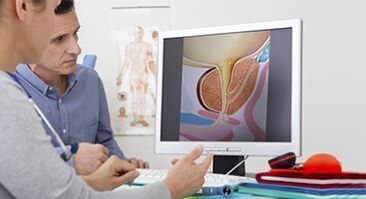Prostatitis and prostate adenoma are diseases that are often diagnosed in men. Not surprisingly, the stronger sex is interested in other symptoms and characteristics. Let’s think about how this pathology is different and how it is treated.

Prostatitis and prostate adenoma are diseases that are often diagnosed in men.
What is the difference between prostate adenoma and prostatitis?
Actually, there is quite a difference.
They are related to the following factors:
- The time of onset of the disease.Prostate adenomas are usually diagnosed in men between the ages of 45-50, and prostatitis also affects the younger limbs of the stronger sex.
- The first symptom.As a rule, with prostatitis, patients complain of discomfort (including quite significant pain), and with adenomas, urinary disorders.
- The reasons.Prostatitis is an inflammatory process and can be triggered by an infection in the genital tract, and prostate adenoma is an excessive growth of tissue due to a variety of factors.
- Clinical picture.Acute prostatitis is often accompanied by chills and fever, and adenomas persist without signs of infection.
- The nature of pain.Inflammation is characterized by acute pain in the groin, perineum and rectum. Tumors in the early stages may not appear in any way. Although pain occurred, it was not significant
For both pathologies, sexual dysfunction is characteristic.
Causes of the development of prostatitis

The disease develops mainly under the influence of microorganisms that enter the prostate gland from various sources. As a rule, prostatitis occurs against the background of sexually transmitted infections.
The disease develops mainly under the influence of microorganisms that enter the prostate gland from various sources.
Some experts distinguish stagnant prostatitis into separate groups. The disease is provoked by a violation of blood circulation in the small pelvis. Against this background, inflammation occurs. The infection is pretty fast. As a result, congestive prostatitis becomes chronic.
Symptoms of the disease
Prostatitis can occur in two forms: acute and chronic.

Not in all cases, acute prostatitis occurs with significant symptoms. A number of men report only general abnormalities, mild pain and temporary impairment of sexual function.
The following symptoms are characteristic of the acute form:
- pain in the perineum;
- pain under the scrotum;
- increased body temperature;
- pain during defecation;
- increased urination;
- the urge to urinate frequently painful;
- erectile dysfunction.
Also, patients complain of purulent discharge and mucus from the urethra, pain in the perineum and groin, excessive excitement, painful ejaculation.
Important! Not in all cases, acute prostatitis occurs with significant symptoms. A number of men report only general abnormalities, mild pain and temporary impairment of sexual function. This symptom is a damp form of prostatitis and resembles a prostate adenoma, which can lead to errors in diagnosis.
Chronic pathology is characterized by 3 main groups of signs:
- It hurts.Men complain of pain in the rectum and lower back, lumbago sensation, tingling and "goose bumps" in the groin, thighs, perineum and buttocks. Against this background, patients can become nervous. Also, men notice sweat and shiver.
- Urinary dysfunction.Men complain of slow urine flow, difficulty emptying the bladder, and frequent urging to the toilet.
- Disorders of sexual function.Patients noted decreased libido, lack of ejaculation or premature ejaculation, difficulty with a full erection. Often against the background of prostatitis, infertility occurs.

The pelvic nerve is often involved in pathological processes. As a result, additional symptoms are added to the main symptoms of prostatitis. They consist of hot flashes and an increase in temperature at night, tachycardia, as well as mood swings and problems concentrating. A number of men complain of fatigue and drowsiness during the day, suspicion, a feeling of lumps in the throat, increased saliva production, weight gain (without changes in diet and physical activity).
The cause of the proliferation of benign glandular tissue is a change in the metabolism of testosterone in the cells.
Causes of the development of prostate adenoma
The cause of the proliferation of benign glandular tissue is a change in the metabolism of testosterone in the cells. This process is unavoidable and begins in men at the age of around 40-45 years. Thus, each representative of the stronger sex faces pathological signs to one degree or another. Usually, benign tumors have no obvious symptoms in the first stage, but are diagnosed already at 2 or 3.
Symptoms of glandular tissue proliferation
The difference between prostatitis and prostate adenoma lies in the main symptoms. With benign tumors, urinary disorders always appear.

The difference between prostatitis and prostate adenoma lies in the main symptoms. With benign tumors, urinary disorders always appear.
They are usually divided into 2 groups:
- Annoying signs.Patients complain of increased desire to urinate, the need to empty the bladder at night periodically, urinary incontinence.
- Obstructive signs.They are the result of narrowing of the urethra with the growth of glands. They manifest themselves in the need to strain when urinating, poor urine flow, dripping drops.
As the disease progresses, the kidneys, ureters and pelvis are involved in pathological processes. This leads to increased blood pressure, back pain, constant thirst, itching, weakness, and deterioration of general well-being. The patient develops pathology of the cardiovascular system. Also, men complain of suppression of sexual function. Complications of prostate adenoma infection were also detected. In some cases, stones form in the bladder. The symptoms of varicose veins (if any) can also get worse.
Principles of treatment of prostatitis and prostate adenoma
Disease therapy is carried out using various groups of drugs.
Treatment for prostatitis aims to:
- suppression of inflammatory processes;
- stop the active reproduction of bacteria;
- increase lymph outflow and blood circulation in the small pelvic veins;
- chronic prevention of pathological processes.
For this purpose, patients are given anti-inflammatory and antibacterial drugs, as well as venotonics and blood thinners. Enzyme agents and immune response stimulants are recommended.
Treatment for prostate adenoma aims to:
- volume reduction;
- normal urinary recovery.
To solve this problem, patients are prescribed alpha-blockers, 5-alpha-reductase inhibitors, phytopreparations and other agents.

Both prostatitis and prostate adenoma may require potential rehabilitation. For this, a combination preparation is prescribed based on herbal ingredients and other components. The funds can be used simultaneously with the treatment of major pathologies. When taken properly, it is not harmful to the body.
Important! Any medication is prescribed by a doctor exclusively. Self -medication is strictly prohibited. It can change the clinical picture and cause difficulties in diagnosis. In addition, medications alone can cause a deterioration in well-being. You also can’t cancel the medication yourself!
In some cases, for the disease, surgical treatment is performed. It is prescribed when conservative therapy is ineffective or inappropriate for one reason or another.
As a rule, surgical intervention is relevant at 2-3 stages of prostate adenoma.
Major operations include:
- TUR (transurethral resection);
- laser treatment;
- laparoscopy;
- intervened using a da Vinci robot.
All operations are minimally invasive. They reduce damage to healthy tissue and provide a short recovery period.

The surgical technique is selected by the physician based on the available indications, the patient’s corresponding disease and his personal characteristics.
Successful treatment of prostate adenoma and prostatitis includes:
- Stopping bad habits (smoking and alcohol abuse);
- Exclusion of animal fats, as well as canned, smoked and fried foods;
- Restrictions in a moderate carbohydrate diet;
- Intake of an adequate amount of fluid in the body (at least 2 liters of water);
- Regular visits to your doctor. You should contact him even if there are no signs of pathology. This will allow the timely introduction of all changes and prevent the development of complications.
Benefits go to the clinic
- Experienced doctor.Our specialists have long been involved in the diagnosis and therapy of prostate pathology. They have the knowledge and skills needed to perform various manipulations.
- Possibility for fast diagnostics.Our specialists use expert class equipment. It allows you to make a diagnosis on the day of treatment.
- An individual approach to therapy.Treatment of prostatitis and prostate adenoma is provided taking into account the type and degree of the disease, the characteristics of the patient, as well as the comorbidities he suffers from.
- Conservative therapy uses modern techniques.
- Modern methods of surgical treatment.Surgical intervention is performed using lasers and da Vinci robots. Laparoscopic surgery and TUR (transurethral resection) were performed. This allows you to reduce the risk of intervention and recovery time.
- Comfort of visiting the clinic.They are located near the metro. In addition, we have taken care of the absence of queues and are ready to receive patients at a time that is convenient for them.
























